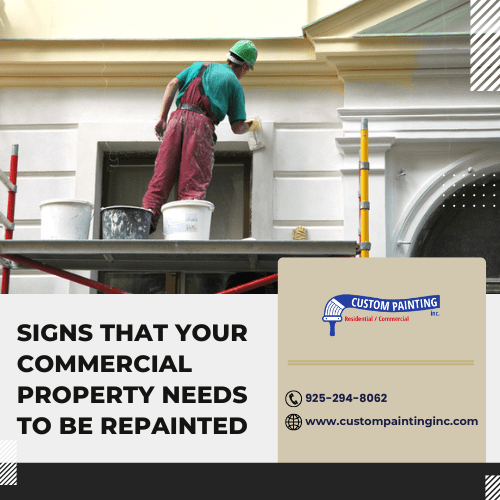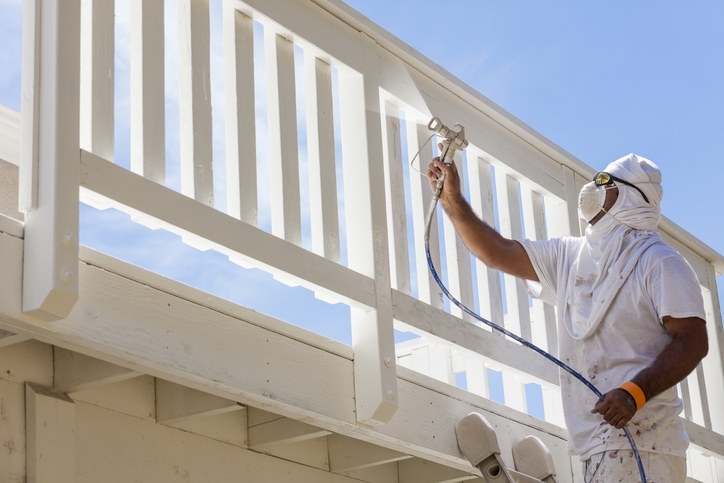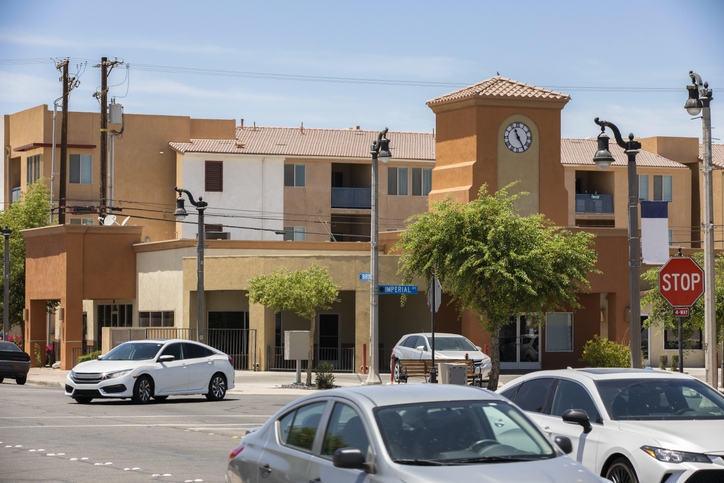If you own or manage a commercial building, you know that appearances matter a lot – they can make or break your business. For example, extend the life of your entryways with specialized rusty metal door painting that resists corrosion and wear.
Maintaining a commercial property’s appearance is crucial as it directly influences customer perceptions, employee morale, and the overall brand image. A well-maintained exterior can attract more clients, convey professionalism, and give a positive first impression.
The paint’s condition significantly impacts the overall perception of the business. Properly and freshly applied paint suggests attention to detail, quality, and care. In contrast, peeling or faded paint can imply neglect. Not only that, but it can also reduce the perceived value and trustworthiness of the business. Regular upkeep of the paintwork helps sustain an inviting and reputable image.
Physical signs
1. Fading colors
Fading colors on a commercial property often result from prolonged exposure to sunlight and harsh weather conditions. Ultraviolet (UV) rays break down the chemical bonds in paint, causing colors to fade and lose their vibrancy. Weather conditions such as rain, snow, and wind also contribute to the wear and tear of paint, accelerating the fading process.
Faded paint significantly diminishes the visual appeal of a property, making it look neglected and outdated. It can negatively affect the business’s image and deter potential clients or customers who might associate the building’s exterior with a lack of professionalism or care.
2. Peeling or cracking paint
Peeling and cracking paint occurs when the paint film loses its adhesion to the surface beneath it. It can be caused by various factors, including improper surface preparation before painting, the application of paint on a dirty or wet surface, or using low-quality paint.
Peeling or cracking paint indicates underlying problems, such as moisture damage. Moisture can seep into the walls, causing the paint to bubble and eventually peel away. If not addressed promptly, this can affect the aesthetics and potentially lead to more severe structural issues.
3. Chalking
Chalking refers to the formation of a fine, powdery residue on the surface of painted walls. It occurs when the paint’s binder breaks down due to exposure to UV light and weathering, leaving behind pigment particles.
Chalking usually results from low-quality paint or improper paint application. It can make the property look dull, unsightly, and unkempt. The powdery substance can rub off on clothing and other surfaces, creating a mess.
4. Mold, mildew, and stains
Mold and mildew growth typically appear as black, green, or brown spots on the surface of painted walls. These fungi thrive in damp, shaded areas where moisture accumulates.
Stains from various sources, such as rust, pollution, or water, can also mar the appearance of a building. Mold, mildew, and stains affect your commercial property’s visual appeal. These stains can also pose severe health risks to occupants. Plus, it can damage the underlying building materials if left untreated.
5. Blistering
Blistering paint occurs when bubbles form under the paint film, causing the paint to lift away from the surface. It is usually an effect of moisture trapped under the paint or painting in direct sunlight or on a hot surface, which causes the paint to dry too quickly.
So, what are blistering paint’s consequences? It can lead to larger sections of paint peeling away, exposing the underlying material to further damage. It can compromise the paint’s protective function, leading to increased maintenance costs and potential structural issues over time.
Functional signs
1. Protection from the elements
Role of paint in protecting the building from weather, moisture, and pests:
- Weather: Paint protects the surfaces from rain, snow, and UV rays, preventing weathering and deterioration.
- Moisture: A good coat of paint prevents moisture from seeping into the building materials, potentially causing rot, mold, and mildew.
- Pests: Paint can seal tiny cracks and crevices, making it harder for pests to enter and cause damage.
Signs that the paint is no longer providing adequate protection:
- Peeling or cracking: Either issue indicates that the paint has lost adhesion due to weathering or moisture.
- Fading: UV rays can break down the paint’s pigments, indicating that it’s no longer protecting the surface from sun damage.
- Blistering: Bubbles or blisters in the paint suggest moisture trapped underneath, pointing to potential water infiltration.
- Chalking: A chalky residue on the paint surface means it is breaking down and no longer effectively shielding the building.
2. Maintenance of structural integrity
How damaged paint can lead to further structural issues:
- Water damage: If paint fails, water can penetrate and cause wood to rot, metal to rust, and concrete to weaken.
- Pest infestation: Cracks in the paint can allow pests like termites or ants to infiltrate and damage the structure from within.
- Decay and Rot: Persistent exposure to moisture can lead to mold growth and decay, compromising the integrity of wooden structures.
Importance of addressing paint issues to prevent costly repairs:
- Early intervention: Repainting at the first signs of wear can prevent minor issues from escalating into severe structural damage.
- Cost savings: Addressing paint problems early avoids expensive repairs such as replacing rotten wood or dealing with mold remediation.
- Preservation of value: Regular maintenance, including repainting, preserves the property’s aesthetic appeal and market value, making it more attractive to tenants and buyers.
Business considerations
1. Brand image and perception
The impact of a well-maintained exterior of a commercial building on customer perception and brand image
A well-maintained commercial building exterior significantly influences customer perception and brand image. Here’s how:
- Professionalism and trustworthiness: A clean and well-kept building exterior conveys professionalism and attention to detail, making customers more likely to trust and engage with the business.
- First impressions: The exterior’s appearance is often the customers’ first reaction towards a business. A visually appealing building can create a positive first impression, encouraging customers to enter and explore the business further.
- Brand identity: The building’s appearance reflects the brand’s values and identity. Consistent maintenance and design coherence with the brand’s aesthetics reinforce the brand message and identity.
- Customer experience: A pleasant exterior enhances the overall customer experience, contributing to customer satisfaction and loyalty.
Examples of how fresh paint can attract more customers
- Vibrant and inviting look: Fresh, vibrant paint can make a building stand out, drawing the attention of potential customers who might otherwise pass by without noticing.
- Updated and modern appearance: Regular painting keeps a building looking modern and up-to-date, which can attract customers seeking contemporary and current businesses.
- Color psychology: Specific colors can evoke particular emotions and behaviors. For example, warm colors like red and yellow can create a sense of urgency and excitement, potentially increasing foot traffic and impulse visits.
2. Compliance with Regulations
Overview of Local Regulations and Standards for Commercial Property Maintenance
Local regulations and standards for commercial property maintenance typically encompass:
- Building codes: Regulations ensuring the structural integrity and safety of commercial properties.
- Health and safety standards: Requirements to ensure the property does not pose health risks to occupants and visitors.
- Zoning laws: Rules governing the use of the property and aesthetic guidelines to maintain a consistent community appearance.
- Environmental regulations: Standards to ensure environmentally friendly practices, such as proper waste disposal and use of non-toxic paints.
Importance of regular repainting to comply with these standards
- Preventing deterioration: Regular repainting prevents the exterior surfaces from deteriorating, which can lead to structural issues and violations of building codes.
- Health and safety compliance: Maintaining paint can prevent mold and mildew growth, ensuring the building meets health and safety standards.
- Aesthetic regulations: Many localities have aesthetic guidelines that require properties to maintain a particular look. Regular repainting helps in adhering to these regulations.
- Environmental compliance: Using eco-friendly paints during repainting can help meet environmental standards and avoid penalties for non-compliance.
Economic indicators
Decline in property value
How can the condition of the paint affect a commercial property’s market value?
- First impressions: A commercial property’s exterior significantly impacts potential buyers’ or tenants’ first impressions. Worn, faded, or peeling paint can suggest neglect, which may reduce the property’s perceived value.
- Perceived maintenance: Poor paint condition indicates underlying maintenance issues, leading buyers or tenants to anticipate future repairs. This perception can lower the market value.
- Aesthetic appeal: The visual appeal of a property is crucial in attracting and retaining tenants. A property with a well-maintained paint job looks more attractive and can command higher rents or sale prices.
Benefits of repainting in maintaining or increasing property value
- Enhanced curb appeal: Repainting improves the property’s appearance, making it more attractive to potential buyers or tenants.
- Protection from the elements: Quality paint protects the surfaces against weather, moisture, and other environmental factors, preventing structural damage and preserving the building’s integrity.
- Market competitiveness: A freshly painted property stands out in the market, potentially leading to faster sales or lease agreements at better rates.
- Positive perception: Repainting can signal to buyers or tenants that the property has been well-maintained, reducing concerns about hidden issues and increasing their willingness to invest.
Investment in longevity
Cost-benefit analysis of repainting versus long-term damage costs
- Initial costs vs. long-term savings: The cost of repainting a property is relatively low compared to the potential costs of repairing damage caused by neglected maintenance, such as water damage, mold, or structural issues.
- Preventive measure: Regular repainting acts as a preventive measure. It extends the exterior’s material lifespan and reduces the need for more expensive repairs or replacements in the future.
- Property value: Investment in regular repainting helps maintain or increase the property’s market value, offering better returns if the property is sold or leased.
Financial advantages of regular maintenance and repainting
- Reduced repair costs: Regular maintenance, including repainting, helps identify and address minor issues before they become major, costly repairs.
- Increased property value: Well-maintained properties tend to appreciate and increase their value, providing better financial returns over time.
- Higher rental income: Properties in good condition can command higher rental rates, ensuring a steady income stream.
- Lower vacancy rates: Attractive, well-maintained properties are more likely to attract and retain tenants, reducing the financial impact of vacancies.
- Insurance benefits: Properties with regular maintenance records, including repainting, might be eligible for lower insurance premiums, reflecting the reduced risk of damage claims.
Conclusion
Repainting a commercial property is a significant investment. It is crucial for maintaining the building’s appearance, safety, and value. Physical signs – from fading colors to blistering – call for prompt action to repaint your commercial property. Otherwise, it will lead to further structural issues, ranging from water damage to rotting.
Property owners should take proactive steps to maintain their buildings to prevent costly repairs, ensure tenant satisfaction, and maintain property value. Regular inspections, timely repairs, and routine maintenance can prevent minor issues from becoming major problems. Such actions also enhance the building’s overall safety and longevity. Proactive upkeep preserves the property’s aesthetic appeal. It also contributes to a healthier living environment, ultimately protecting your investment.
Would you like to improve and enhance your business atmosphere with new paint? If your answer is yes, hire a reliable Bay Area painting contractor like Custom Painting, Inc. Serving the Bay area including the cities of Moraga, Mountain View, Orinda, Pleasant Hill and San Jose.
We’re a proven company with solid experience, reputation, and customer reviews with 5-star ratings. Call us at 925-294-8062 or complete our contact form. We provide free painting estimates, and no strings are attached!




